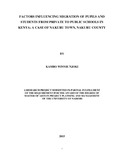| dc.description.abstract | Pupils and Students migration from one school to another may be influenced by several factors
such as race and ethnicity, socio-economic status, residential status and student’s performance.
Lately, there is a trend in Kenya where pupils and students are now migrating from private to
public schools. The aforementioned migration results in enrollment and resources imbalances. In
spite of the enormity of this problem, the reasons for migrating of pupils and students from
private to public schools hitherto remain an abnormal behavior since it expected that the
migration should be from public to private school. This is due to the fact that private schools are
more prestigious, have better facilities, enough teaching staff among other resources. It is against
this backdrop, therefore, that this study is necessitated. The study sought to establish the factors
that influence migration of students from private to public schools. The study was conducted in
Nakuru town, Kenya. It was limited to four specific objectives which aimed to find out how
secondary school entry quota system, planning cost of education, academic performance and
socio-economic planning determine the aforesaid students’ migration. The study was guided by
rational choice and educational productivity theories. A descriptive research design was adopted.
The study targeted all the 172 administrative staff working with public primary and secondary
schools in Nakuru town. A sample of 64 respondents was selected using stratified random
sampling method. Data was collected using a structured questionnaire. The collected data were
analyzed with the aid of the Statistical Package for Social Sciences software. Data analyses
constituted frequencies, percentages, means, standard deviations and multiple regression
analysis. The study findings were presented in form of statistical tables. It was revealed that the
relationship between entry quota system and pupils and students migration was positive and
weak. On the other hand, cost of education planning, academic performance and social economic
planning had strong and significant effect on students and pupils migration from private to public
schools. The study concluded that the aforestated factors were of fundamental importance in
addressing the issue of pupils and students migration. It was recommended that secondary school
entry quota system should uphold fairness and equitability; the parents and guardians ought to be
economically empowered in order to support their children in pursuit of education; and the
Ministry of Education should inspect both private and public schools on similar bases in order to
avoid prejudicing certain categories of schools. | en_US |

